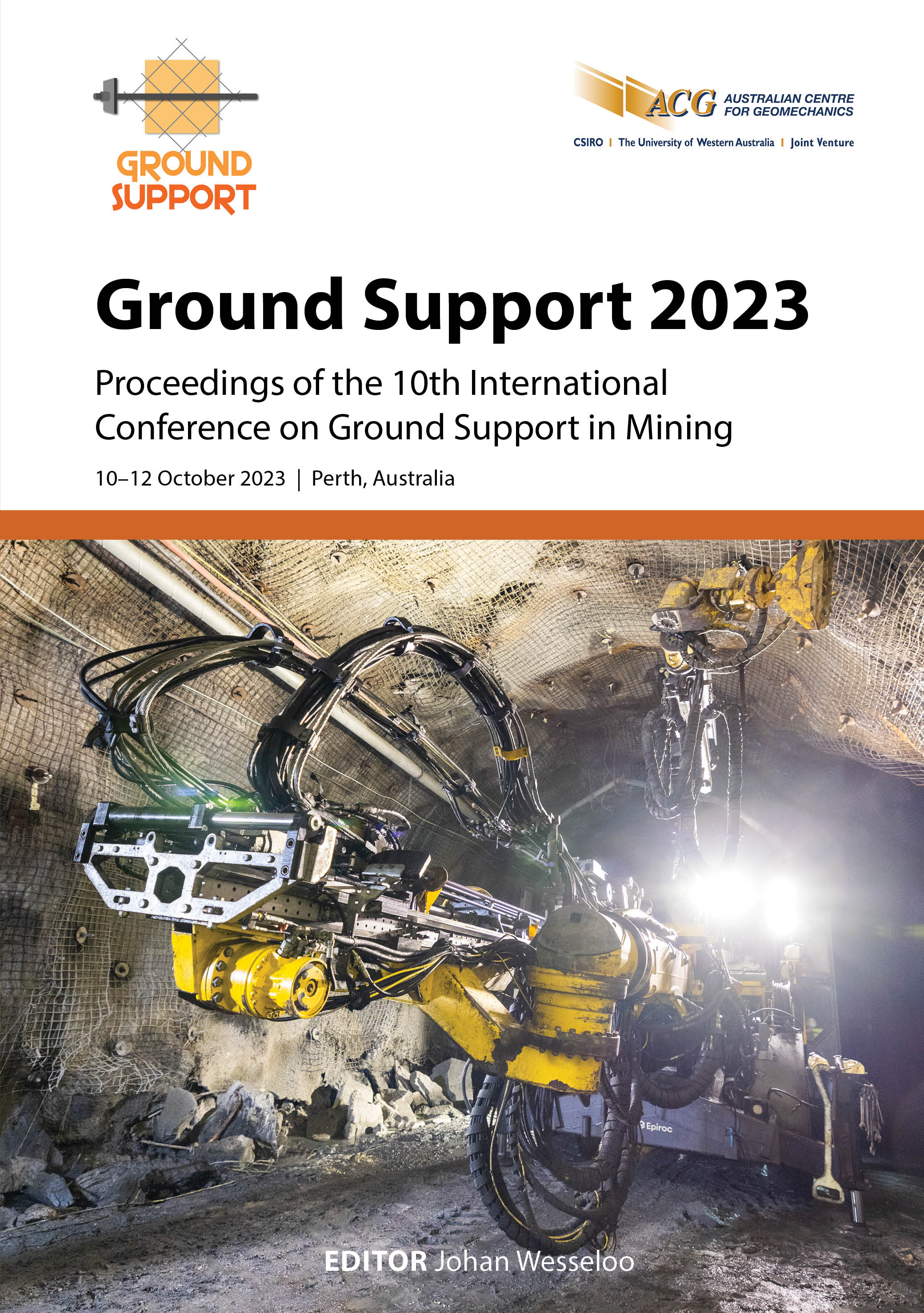Importance and development of pre-tension on bolt support systems: implications to hanging wall beam stability

|
Authors: Masitise, MN; Muzavazi, M |
DOI https://doi.org/10.36487/ACG_repo/2325_30
Cite As:
Masitise, MN & Muzavazi, M 2023, 'Importance and development of pre-tension on bolt support systems: implications to hanging wall beam stability ', in J Wesseloo (ed.), Ground Support 2023: Proceedings of the 10th International Conference on Ground Support in Mining, Australian Centre for Geomechanics, Perth, pp. 453-460, https://doi.org/10.36487/ACG_repo/2325_30
Abstract:
Stratified and often discontinuous excavation roofs or hanging walls have traditionally produced challenges in mining because of the condition of the hanging wall beam. A zone above the hanging wall exists where the strata forming the hanging wall beam are in tension, which tends to dilate, buckle, and delaminate, eventually falling out if not clamped. Introducing tensioned tendons in this system helps immobilise the individual blocks and clamp the strata, thus improving the stability of the hanging wall beam. There are different systems of tendon or bolt installations. Tensioned bolts are more efficient because a more stable beam can be built with the same bolt by applying a larger installed tensile load. Active pre-loads modify roof behaviour by dramatically reducing bed separation and delamination clamping together with thinly laminated roof beds, forming thicker beams and eliminating bed separations, thus restoring the structural integrity of the roof. The performance of the equipment used to install the roofbolts affects the quality of bolt installation. The first challenge is achieving the desired pre-tension load during installation, and the second is the logistics of generating the required torque using handheld equipment in some cases. Torque wrenches overestimate the pre-tension loads because of frictional losses when the bolt head is tensioned against the plate. Steel wire strand bolts encapsulated in resin (flexible bolts) generally have a high load-bearing capacity and are perfect candidates for pre-tensioning. More than 80% of the strand-type bolts used worldwide are pre-tensioned to approximately 15 t or more, and the growth of this practice provides circumstantial evidence of effectiveness. Mohlalefi Engineering developed a patented, efficient torque multiplier system with a dualsocket configuration to allow the generation of pre-tension loads up to 20 t for strand bolts and by extension arresting pre-tension decay through the provision of a primary stationary nut–socket interface (anti-spin mechanism). The system can be used on small drill rigs with an output spindle torque of 80 Nm, as well as in modern hydraulic drill rigs that produce output torques between 240 and 400 Nm. Following underground installations carried out with the dual-socket torque multiplier at Mototolo platinum mine, in Limpopo province, South Africa, it was possible to pre-tension flexible bolts to 15 t using a conventional bolter. Destructive lab tests were conducted on the Mohlalefi Anchorflex, which aimed to determine the overall system resistance and safe working load. The resistance achieved ranged from 299.6–300.3 KN and all strands were threaded at both ends and held in place by nuts. The failure mode was strand breakage in all cases. The Mohlalefi torque multiplier can achieve pre-tension loads of up to 15 t on flexible bolts with a minimum breaking load of 30 t. A comparison of the input force or pressure with the torque achieved gives a clear indication of the efficiency of the system.
Keywords: pre-tension, anti-spin, torque multiplier, beam stability, cable bolts
References:
Barczak, TM & Gearhart, DF 1993, Engineering Methods for Design and Employment of Wood Cribs, U.S. Bureau of Mines Information Circular 9361, Washington.
Barczak, TM & Gearhart, DF 1995, ‘Renewed interest in prop supports as a replacement for wood cribs’, in SS Peng (ed.), Proceedings, 14th International Conference on Ground Control in Mining, West Virginia University, Morgantown, pp. 149–158.
Barczak, TM, Bower, J & Chen, J 2003, ‘Pumpable roof supports: developing design criteria by measurement of the ground reaction curve’, in SS Peng (ed.), Proceedings of the 22nd International Conference on Ground Control in Mining, West Virginia University, Morgantown, pp. 283–293.
Fuller, PG & Grandy, PO 1993, ‘Flexible roof bolts: a new concept for strata control’, in SS Peng (ed.), Proceedings of the 12th International Conference on Ground Control in Mining, pp. 24–34.
Rataj, M 2002, ‘Improvement in pre-tensioning of strand bolts in Australian coal mines’, in SS Peng, C Mark, AW Khair & K Heasley (eds), Proceedings, 21st International Conference on Ground Control in Mining, West Virginia University, Morgantown, pp. 145–149.
Rataj, M & Thomas, R 1997, ‘New methods, and technologies of roof bolting in Australian coal mines’, in SS Peng (ed.), Proceedings, 16th International Conference on Ground Control in Mining, West Virginia University, Morgantown, pp. 149–157.
© Copyright 2025, Australian Centre for Geomechanics (ACG), The University of Western Australia. All rights reserved.
View copyright/legal information
Please direct any queries or error reports to repository-acg@uwa.edu.au
View copyright/legal information
Please direct any queries or error reports to repository-acg@uwa.edu.au
